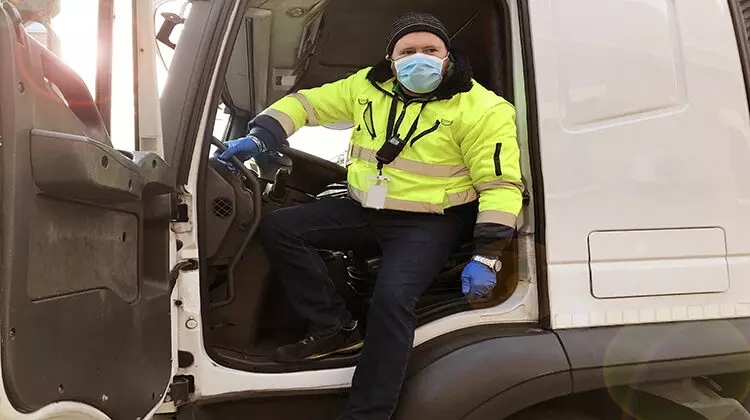Challenges for the Flatbed Shipping Companies trucking industry remain difficult as Rhode Island Heavy Hauler truckers excel even as the COVID-19 pandemic continues. Key supplies and components are causing the deliveries of others to become strained. The added burden of this Holiday season has increased the logistical challenges for flatbed trucking companies. Keeping the shelves full of certain products during this unusual disruption is the challenge even for simple items like toilet paper, hams, and biscuits! Strategic supplies to hospitals and health care workers have taken priority as the pandemic continues.

The movement of goods is an essential operation needed to continue. Vehicle manufacturers shifted to produce personal protective supplies. Operational fleets now were delivering medical supplies, groceries, and yes toilet paper! The industries, van and flatbed trucking companies stepped up and made the sacrifices needed to get the job accomplished. Once this new supply flow was accepted as the current new normal an unusual mix of balancing assets, personnel, responsibilities, processes, and on-the-fly changes was put into effect as a catalyst for meaningful long-term changes. “It is not the strongest or the most intelligent who will survive, but those who can best manage change.” Charles Darwin
Now that the vaccines are ready to be distributed, they will add to the disruption of the supply chain. Leading causes are the eighty thousand fewer drivers than last year’s numbers and the hoarding of certain supplies leaving unproportioned stock on the shelves for other consumers. Factories continue to reopen after pandemic-related shutdowns even though holiday-related gatherings could reverse this trend as the pandemic rears its ugly head spiking once more.

Usually, flatbed shipping companies have enough additional equipment and drivers to handle the uptick during holiday times, however with the pandemic causing a concerning imbalance of these resources the industry has felt the negative results. Luckily, some of this disruption has been decreased due to the capital investments during the Trump bump tax cuts enabling companies to acquire new equipment and continue efforts to recruit and train new drivers.
All standard and over-dimensional freight rates have been driven to new heights, typically a win for the trucking industry; but seemingly untenable in the future. Drivers are working nonstop eliminating the flexibility and ability of flatbed shipping companies to react to change spontaneously. Driver capacity now has a greater effect on fleet capacity and utilization rates.
Adding to this driver shortage and the pandemic transportation conundrum is the closing of driver training schools and license testing sites, stricter drug testing, and unemployment benefits on steroids. These closures will drop the CDL supply chain of holders to a mere forty percent. Forty thousand drivers alone were lost to the more aggressive drug and alcohol testing that prevents violators from seeking reemployment in the industry. As hair follicle testing is rolled out these numbers can become catastrophic to the industry eliminating over one hundred thousand drivers. As hoarding ramps up again the freight industry will be further strained driving up rates and shortages of certain goods. Looking at the positive side increased rates will mean higher incomes for drivers attracting more people to the industry.
Oversize Trucking Companies from Rhode Island to Alabama
Oversize Trucking Companies from Rhode Island to Arkansas
Oversize Trucking Companies from Rhode Island to Arizona
Oversize Trucking Companies from Rhode Island to California
Oversize Trucking Companies from Rhode Island to Colorado
Oversize Trucking Companies from Rhode Island to Connecticut
Oversize Trucking Companies from Rhode Island to Delaware
Oversize Trucking Companies from Rhode Island to Florida
Oversize Trucking Companies from Rhode Island to Georgia
Oversize Trucking Companies from Rhode Island to Idaho
Oversize Trucking Companies from Rhode Island to Illinois
Oversize Trucking Companies from Rhode Island to Indiana
Oversize Trucking Companies from Rhode Island to Iowa
Oversize Trucking Companies from Rhode Island to Kansas
Oversize Trucking Companies from Rhode Island to Kentucky
Oversize Trucking Companies from Rhode Island to Louisiana
Oversize Trucking Companies from Rhode Island to Maine
Oversize Trucking Companies from Rhode Island to Marryland
Oversize Trucking Companies from Rhode Island to Massachusetts
Oversize Trucking Companies from Rhode Island to Michigan
Oversize Trucking Companies from Rhode Island to Minnesota
Oversize Trucking Companies from Rhode Island to Mississippi
Oversize Trucking Companies from Rhode Island to Missouri
Oversize Trucking Companies from Rhode Island to Montana
Oversize Trucking Companies from Rhode Island to Nebraska
Oversize Trucking Companies from Rhode Island to Nevada
Oversize Trucking Companies from Rhode Island to New Hampshire
Oversize Trucking Companies from Rhode Island to New Jersey
Oversize Trucking Companies from Rhode Island to New Mexico
Oversize Trucking Companies from Rhode Island to New York
Oversize Trucking Companies from Rhode Island to North Carolina
Oversize Trucking Companies from Rhode Island to South Dakota
Oversize Trucking Companies from Rhode Island to Ohio
Oversize Trucking Companies from Rhode Island to Oklahoma
Oversize Trucking Companies from Rhode Island to Oregon
Oversize Trucking Companies from Rhode Island to Pennsylvania
Oversize Trucking Companies from Rhode Island to Rhode Island
Oversize Trucking Companies from Rhode Island to South Carolina
Oversize Trucking Companies from Rhode Island to South Dakota
Oversize Trucking Companies from Rhode Island to Tennessee
Oversize Trucking Companies from Rhode Island to Texas
Oversize Trucking Companies from Rhode Island to Utah
Oversize Trucking Companies from Rhode Island to Vermont
Oversize Trucking Companies from Rhode Island to Virginia
Oversize Trucking Companies from Rhode Island to Washington
Oversize Trucking Companies from Rhode Island to West Virginia
Oversize Trucking Companies from Rhode Island to Wisconsin
Oversize Trucking Companies from Rhode Island to Wyoming
